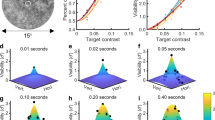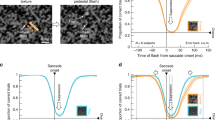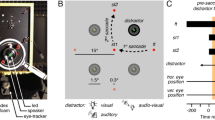Abstract
We scan our surroundings with quick eye movements called saccades, and from the resulting sequence of images we build a unified percept by a process known as transsaccadic integration. This integration is often said to be flawed, because around the time of saccades, our perception is distorted1,2,3,4,5,6 and we show saccadic suppression of displacement (SSD): we fail to notice if objects change location during the eye movement7,8. Here we show that transsaccadic integration works by optimal inference. We simulated a visuomotor system with realistic saccades, retinal acuity, motion detectors and eye-position sense, and programmed it to make optimal use of these imperfect data when interpreting scenes. This optimized model showed human-like SSD and distortions of spatial perception. It made new predictions, including tight correlations between perception and motor action (for example, more SSD in people with less-precise eye control) and a graded contraction of perceived jumps; we verified these predictions experimentally. Our results suggest that the brain constructs its evolving picture of the world by optimally integrating each new piece of sensory or motor information.
This is a preview of subscription content, access via your institution
Access options
Subscribe to this journal
Receive 51 print issues and online access
$199.00 per year
only $3.90 per issue
Buy this article
- Purchase on Springer Link
- Instant access to full article PDF
Prices may be subject to local taxes which are calculated during checkout



Similar content being viewed by others
References
Matin, L. & Pearce, D. G. Visual perception of direction for stimuli flashed during voluntary saccadic eye movements. Science 148, 1485–1488 (1965)
Honda, H. Saccade-contingent displacement of the apparent position of visual stimuli flashed on a dimly illuminated structured background. Vision Res. 33, 709–716 (1993)
Ross, J., Morrone, M. C. & Burr, D. C. Compression of space before saccades. Nature 386, 598–601 (1997)
Morrone, M. C., Ross, R. & Burr, D. C. Apparent position of visual targets during real and simulated saccadic eye movements. J. Neurosci. 17, 7941–7953 (1997)
Cai, R. H., Pouget, A., Schlag-Rey, M. & Schlag, J. Perceived geometrical relationships affected by eye-movement signals. Nature 386, 601–604 (1997)
Lappe, M., Awater, H. & Krekelberg, B. Postsaccadic visual references generate presaccadic compression of space. Nature 403, 892–895 (2000)
Mack, A. An investigation of the relationship between eye and retinal image movement in the perception of movement. Percept. Psychophys. 8, 291–298 (1970)
Bridgeman, B., Hendry, D. & Stark, L. Failure to detect displacement of the visual world during saccadic eye movements. Vision Res. 15, 719–722 (1975)
Westheimer, G. Spatial vision. Annu. Rev. Psychol. 35, 201–226 (1984)
Carpenter, R. H. S. in Vision and Visual Dysfunctions (ed. Carpenter, R. H. S.) 1–10 (Macmillan, Boca Raton, 1991)
Choudhury, B. P. & Crossey, A. D. Slow-movement sensitivity in the human field of vision. Physiol. Behav. 26, 125–128 (1981)
Tynan, P. D. & Sekuler, R. Motion processing in peripheral vision: Reaction time and perceived velocity. Vision Res. 22, 61–68 (1982)
Burr, D. C., Holt, J., Johnstone, J. R. & Ross, J. Selective depression of motion sensitivity during saccades. J. Physiol. (Lond.) 333, 1–15 (1982)
Burr, D. C., Morrone, M. C. & Ross, J. Selective suppression of the magnocellular visual pathway during saccadic eye movements. Nature 371, 511–513 (1994)
Shiori, S. & Cavanagh, P. Saccadic suppression of low-level motion. Vision Res. 29, 915–928 (1989)
Ilg, U. & Hoffmann, K.-P. Motion perception during saccades. Vision Res. 33, 211–220 (1993)
Steinbach, M. J. Proprioceptive knowledge of eye position. Vision Res. 27, 1737–1744 (1986)
von Helmholtz, H. Handbuch der physiologischen Optik (Leopold Voss, Hamburg and Leipzig, 1910)
von Holst, E. & Mittelstaedt, H. Das Reafferenzprinzip (Wechselwirkung zwischen Zentralnervensystem und Peripherie). Naturwissenschaften 37, 464–476 (1950)
Sperry, R. W. Neural basis of the spontaneous optokinetic response produced by visual inversion. J. Comp. Physiol. Psychol. 43, 482–489 (1950)
Dassonville, P., Schlag, J. & Schlag-Rey, M. Oculomotor localization relies on a dampened representation of saccadic eye movement displacement in human and nonhuman primates. Vis. Neurosci. 9, 261–269 (1992)
Honda, H. Interaction of extraretinal eye position signals in a double-step saccade task: Psychophysical estimation. Exp. Brain Res. 113, 327–336 (1997)
Li, W. & Matin, L. The influence of saccade length on the saccadic suppression of displacement detection. Percept. Psychophys. 48, 453–458 (1990)
Li, W. & Matin, L. Saccadic suppression of displacement: Separate influences of saccade size and of target retinal eccentricity. Vision Res. 37, 1779–1797 (1997)
Gysen, V., De Graef, P. & Verfaillie, K. Detection of intrasaccadic displacements and depth rotations of moving objects. Vision Res. 42, 379–391 (2002)
Deubel, H., Schneider, W. X. & Bridgeman, B. Postsaccadic target blanking prevents saccadic suppression of image displacement. Vision Res. 36, 985–996 (1996)
Bridgeman, B., Van der Heijden, A. H. C. & Velichovsky, B. M. A theory of visual stability across saccadic eye movements. Behav. Brain Sci. 17, 247–292 (1994)
MacKay, D. M. in Handbook of Sensory Physiology Vol. VII/3 (ed. Jung, R.) 307–332 (Springer, Berlin, 1973)
Van Opstal, A. J. & Van Gisbergen, J. A. M. Scatter in the metrics of saccades and properties of the collicular motor map. Vision Res. 29, 1183–1196 (1989)
Kontsevich, L. L. & Tyler, C. W. Bayesian adaptive estimation of psychometric slope and threshold. Vision Res. 39, 2729–2737 (1999)
Acknowledgements
We thank S. Sun for invaluable programming, H. Wang for help with experiments, and I. Frenkel, P. Hallett, C. Hawkins, D. Henriques, E. Klier, J. C. Martinez Trujillo, P. Medendorp and K. Schreiber for comments on the manuscript. This study was supported by the Canadian Institutes for Health Research. J.D.C. is supported by the Canadian Research Chair Program.
Author information
Authors and Affiliations
Corresponding author
Ethics declarations
Competing interests
The authors declare that they have no competing financial interests.
Rights and permissions
About this article
Cite this article
Niemeier, M., Crawford, J. & Tweed, D. Optimal transsaccadic integration explains distorted spatial perception. Nature 422, 76–80 (2003). https://doi.org/10.1038/nature01439
Received:
Accepted:
Issue Date:
DOI: https://doi.org/10.1038/nature01439
This article is cited by
-
Coupling perception to action through incidental sensory consequences of motor behaviour
Nature Reviews Psychology (2022)
-
Displacement detection is suppressed by the post-saccadic stimulus
Scientific Reports (2020)
-
Working memory in action: inspecting the systematic and unsystematic errors of spatial memory across saccades
Experimental Brain Research (2019)
-
Distractor displacements during saccades are reflected in the time-course of saccade curvature
Scientific Reports (2018)
-
Suppression of displacement detection in the presence and absence of eye movements: a neuro-computational perspective
Biological Cybernetics (2016)
Comments
By submitting a comment you agree to abide by our Terms and Community Guidelines. If you find something abusive or that does not comply with our terms or guidelines please flag it as inappropriate.



